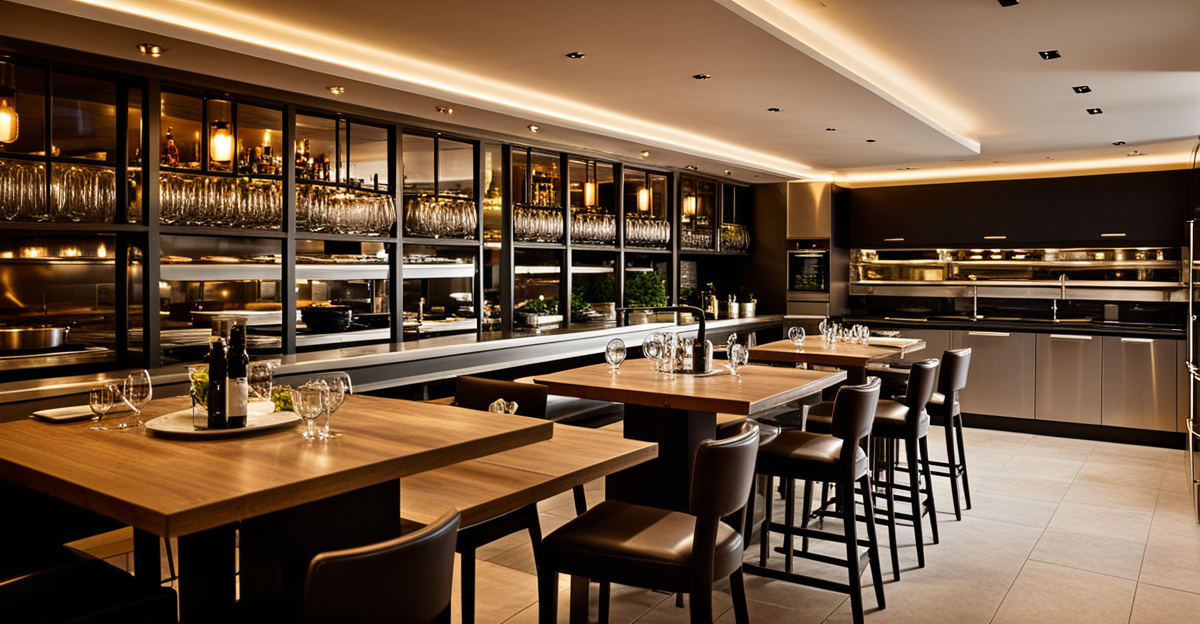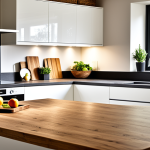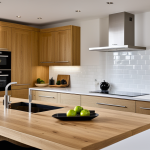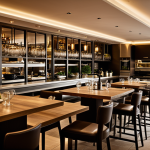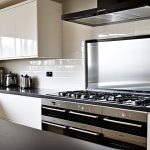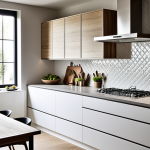Influence of Interior Design on UK Kitchen Restaurant Ambiance
Interior design has a profound impact on the sensory and emotional atmosphere of UK kitchen restaurants. It shapes the restaurant atmosphere by blending visual appeal, tactile elements, and spatial organization that together create an immersive experience. For customers, this translates into emotions ranging from comfort to excitement, directly influencing their perception and enjoyment. For staff, a well-designed environment fosters efficiency and reduces stress, contributing to a smooth operation.
In the UK, distinct trends in interior design focus on balancing tradition with modernity. Many kitchen restaurants integrate elements like exposed brick walls or reclaimed wood to evoke warmth, simultaneously incorporating sleek metallic accents to signify professionalism. This combination shapes a unique UK kitchen restaurant ambiance that appeals broadly.
Also to discover : What are the challenges of running a UK restaurant kitchen during peak hours?
The importance of ambiance extends beyond aesthetics; it influences behavior and decision-making. A welcoming, thoughtfully arranged space encourages longer visits and repeat patronage. Similarly, a functional layout and pleasant surroundings improve staff well-being and operational flow. Thus, interior design impact in UK kitchen restaurant ambiance plays a crucial role in harmonizing customer experience with staff performance, making it a cornerstone of successful hospitality venues.
Influence of Interior Design on UK Kitchen Restaurant Ambiance
Interior design profoundly shapes the UK kitchen restaurant ambiance by engaging both sensory and emotional responses. The choices in decor, lighting, and spatial arrangement influence how customers perceive the restaurant atmosphere—creating feelings of warmth, excitement, or relaxation that directly impact dining satisfaction. For example, tactile materials alongside subtle lighting can invoke comfort, while vibrant colors may energize the space.
Also read : What impact does interior design have on UK kitchen restaurant ambiance?
Distinct trends in the UK emphasize authenticity and locality, with many kitchen restaurants embracing minimalist designs that highlight open kitchens and natural materials. These elements foster transparency and connection between diners and chefs, enhancing trust and engagement. Interior design impact extends beyond customers; it affects staff comfort and workflow efficiency too. A carefully crafted ambiance supports employee well-being, reducing stress and improving performance.
In essence, the interior design impact goes beyond aesthetics. It is instrumental in establishing an environment where both visitors and staff thrive, underpinning successful hospitality operations through a balanced, inviting atmosphere. This makes investing in thoughtful design a strategic priority for UK kitchen restaurants aiming to differentiate themselves in a competitive market.
Key Interior Design Elements Affecting Ambiance
Interior design elements are pivotal in defining the UK kitchen restaurant ambiance. Among these, lighting in restaurants stands out as a critical factor. Soft, warm lighting can create a cozy and inviting restaurant atmosphere, encouraging diners to relax and stay longer. Conversely, brighter task lighting enhances functionality, particularly around food preparation areas where visibility is essential.
Colour schemes significantly influence emotional responses. Earthy tones, such as muted greens and browns, often evoke comfort and natural warmth, aligning well with traditional UK kitchen themes. In contrast, bold, contrasting colours can add energy and modernity, impacting how customers perceive the space emotionally.
The restaurant layout also plays a crucial role. A well-organized spatial arrangement optimizes flow, reducing bottlenecks that could disrupt staff efficiency and detract from the customer’s experience. An open-plan kitchen, for example, fosters transparency and engagement, enhancing ambiance while supporting operational efficiency.
Materials used—like reclaimed wood, exposed brick, or stainless steel—contribute tactile and visual interest, directly affecting the sensory atmosphere. These elements, carefully curated, combine to enhance the overall interior design impact on both customers and staff, shaping an authentic and comfortable venue experience.
Key Interior Design Elements Affecting Ambiance
Effective interior design elements are central to crafting the UK kitchen restaurant ambiance. One primary factor is lighting in restaurants, which sets both mood and functionality. Soft, warm lighting creates an inviting and relaxing restaurant atmosphere, encouraging diners to linger and enhancing their overall satisfaction. Conversely, bright, focused lighting can highlight culinary preparations and increase staff efficiency.
Colour schemes play a significant role, too. Neutral tones combined with natural materials like wood or stone provide warmth and authenticity, resonating with the UK’s trend toward minimalist, organic aesthetics. Vibrant accent colours strategically placed can energize spaces without overwhelming guests, balancing calmness with liveliness.
Another crucial element is restaurant layout—the spatial organization affects how patrons move and interact within the venue. An open, flowing layout reduces congestion, facilitates service, and promotes a sense of openness, positively influencing both comfort and perception of space. Careful consideration of pathways and seating arrangement ensures a seamless experience for customers and allows staff to move efficiently.
Together, these interior design elements—lighting, colour, materials, and layout—interconnect to mold the sensory and emotional atmosphere that defines the UK kitchen restaurant ambiance.
Influence of Interior Design on UK Kitchen Restaurant Ambiance
Interior design impact is central to shaping the UK kitchen restaurant ambiance by engaging multiple senses and emotions. The design decisions create a restaurant atmosphere that influences how customers feel: relaxed, energized, or connected. For example, materials that evoke warmth—such as reclaimed wood—combine tactile comfort with visual appeal, encouraging patrons to feel at home.
UK kitchen restaurant ambiance often reflects a blend of tradition and innovation. Designers incorporate authentic, local elements alongside modern finishes, fulfilling evolving customer expectations. This approach not only defines the restaurant atmosphere but also supports staff wellbeing by providing clear, functional spaces that reduce stress.
The importance of ambiance extends beyond appearance: it directly impacts customer behavior and staff productivity. A thoughtfully crafted environment invites longer visits and repeat business, while enabling efficient workflows behind the scenes. By balancing sensory appeal with practical layout, the interior design impact enhances the harmony between customer satisfaction and staff performance, a priority for UK hospitality venues aiming to excel.
Influence of Interior Design on UK Kitchen Restaurant Ambiance
The interior design impact on UK kitchen restaurant ambiance fundamentally shapes the restaurant atmosphere by engaging senses and emotions. Interior design goes beyond decoration; it creates an environment that evokes specific feelings, influencing how customers and staff experience the space. Subtle lighting manipulations, combined with tactile materials and considered spatial flow, elicit comfort, excitement, or calmness, directly affecting diner satisfaction and staff efficiency.
United Kingdom kitchen restaurants often reflect a distinctive balance between tradition and innovation. This balance is seen in design choices that merge rustic elements like reclaimed wood or vintage tiles with clean, modern lines and fixtures. Such combinations resonate deeply in UK hospitality venues, fostering authenticity while appealing to contemporary tastes. This synthesis of old and new within the interior design impact supports a memorable restaurant atmosphere that encourages longer visits and repeat patronage.
Moreover, ambiance affects operational dynamics; it’s integral to staff well-being and performance. A harmonious UK kitchen restaurant ambiance reduces workplace stress and streamlines workflow, demonstrating how design principles tailored thoughtfully contribute to both guest enjoyment and efficient service. Such comprehensive design strategies underscore the vital role of interior design in shaping successful hospitality environments.
Influence of Interior Design on UK Kitchen Restaurant Ambiance
Interior design impact plays a vital role in shaping the UK kitchen restaurant ambiance by engaging both sensory perception and emotional responses. This influence goes beyond simple decoration; it creates a nuanced restaurant atmosphere that affects how customers feel—whether calm, energized, or connected to the dining experience. For instance, tactile elements like natural wood combined with ambient lighting can evoke warmth and comfort, fostering a welcoming environment that encourages longer visits.
Distinct UK trends in interior design emphasize the integration of traditional materials with modern stylistic touches. This blend reflects local heritage while embracing contemporary aesthetics, which shapes the overall ambiance in a manner unique to UK hospitality venues. These trends also prioritize transparency and openness, often through open-plan kitchens, which visually connect diners to the culinary process, enhancing trust and engagement.
Ambiance greatly affects both patron satisfaction and staff well-being. A thoughtfully curated restaurant atmosphere can reduce stress for employees by optimizing workflow through functional layout and lighting choices. In parallel, customers benefit from environments tailored to create emotional resonance and a sense of belonging, proving that interior design impact is instrumental in fostering harmonious and efficient restaurant operations.
Influence of Interior Design on UK Kitchen Restaurant Ambiance
Interior design impact is pivotal in crafting the distinctive UK kitchen restaurant ambiance, shaping both the restaurant atmosphere and the emotional responses of patrons. How does interior design influence these sensory and emotional experiences? It orchestrates a blend of lighting, textures, materials, and spatial flow that directly affect comfort, excitement, or calmness within the venue. For instance, employing warm, natural materials alongside strategic lighting schemes engages multiple senses, fostering a welcoming ambiance.
What distinct UK trends define this interior design impact? Many UK kitchen restaurants merge traditional elements—like reclaimed wood and vintage tiles—with minimalist, modern lines. This fusion supports authenticity while addressing contemporary tastes, producing a balanced restaurant atmosphere that resonates with customers seeking both heritage and innovation.
Why is ambiance crucial beyond customer perceptions? The interior design impact also significantly benefits staff. Thoughtful layouts and calming elements reduce workplace stress and enhance operational efficiency, underlining the dual importance of ambiance in supporting both guest satisfaction and staff well-being. Thus, interior design acts as a conduit, harmonizing functional needs with aesthetic appeal in UK kitchen restaurants.

